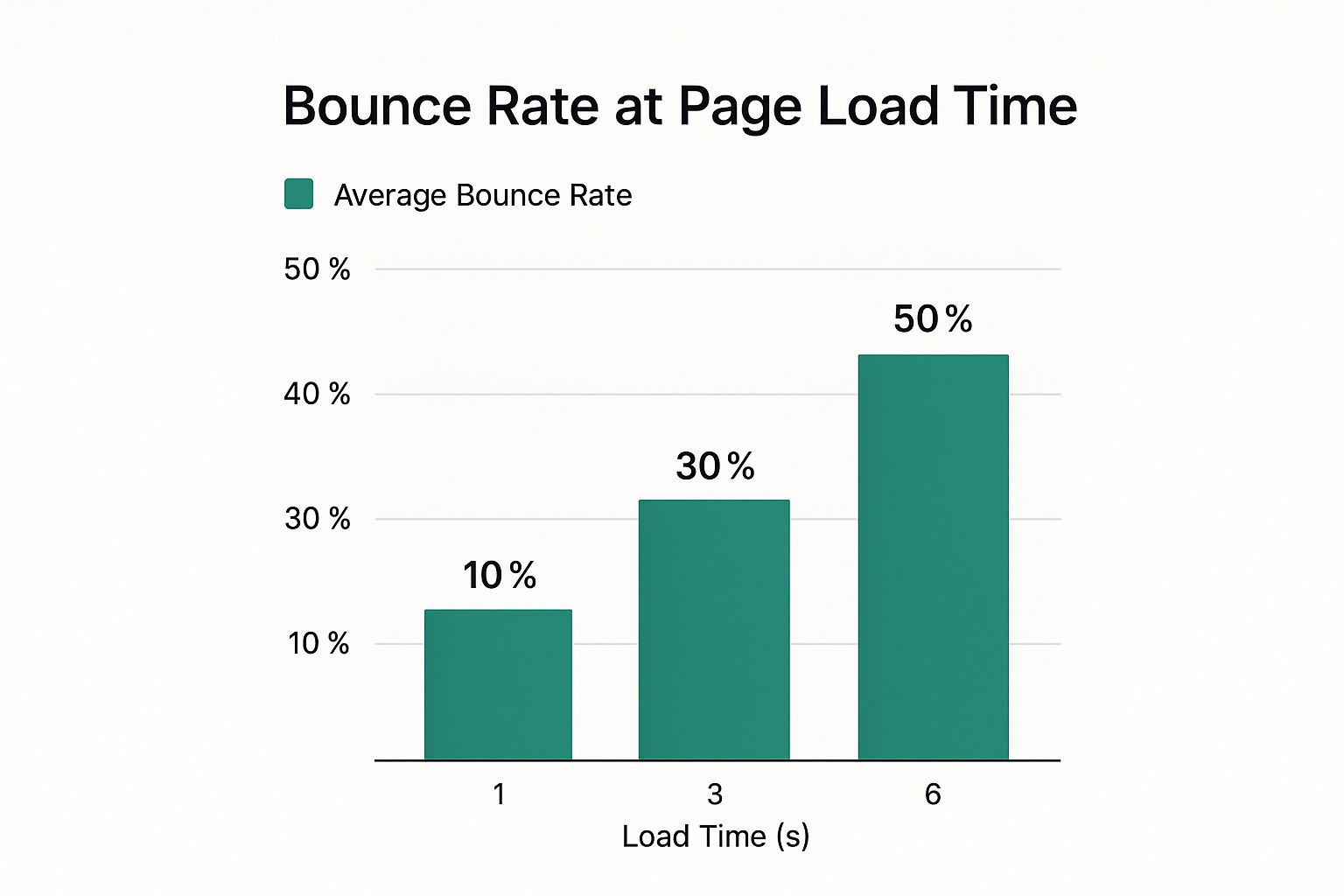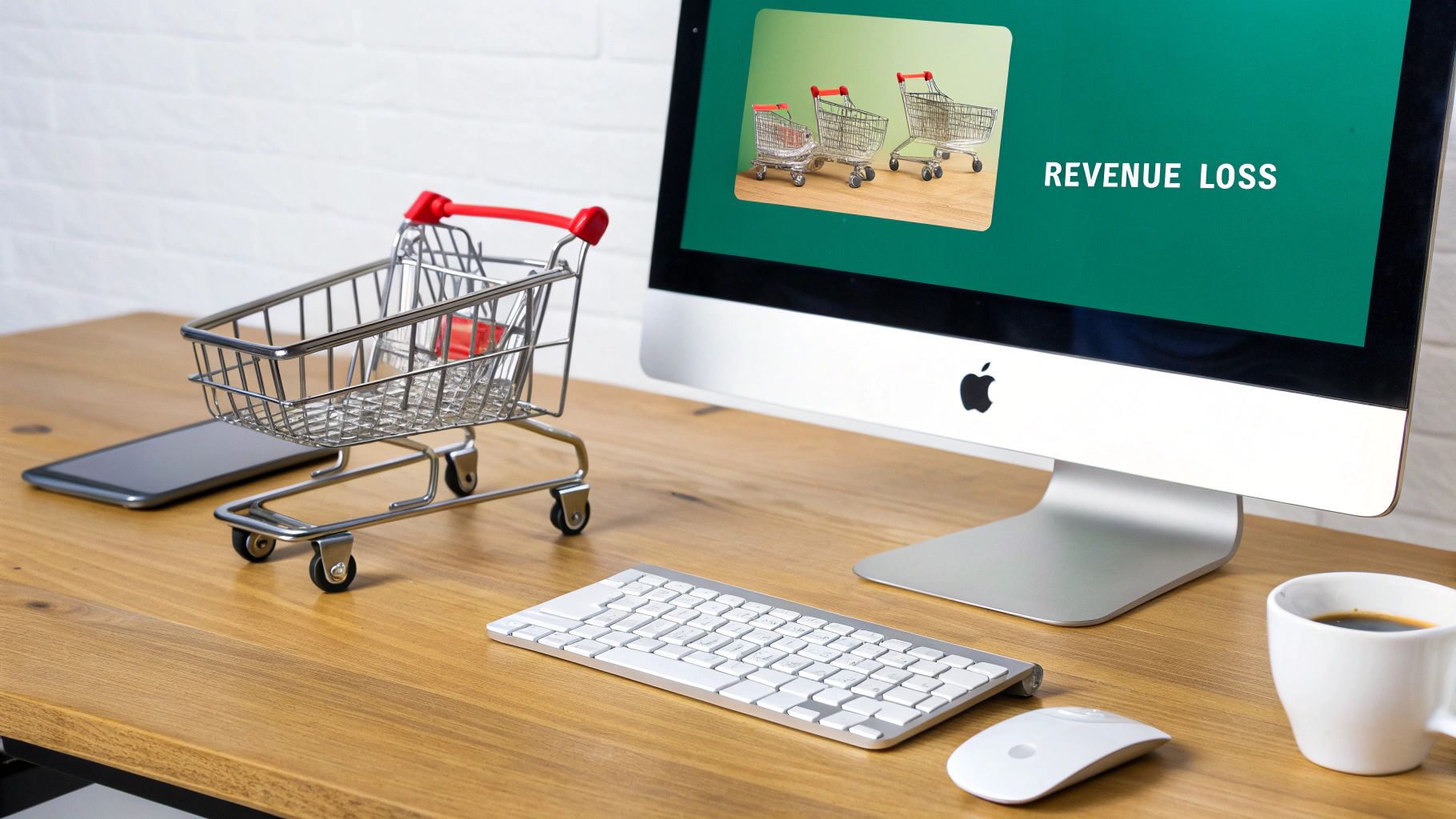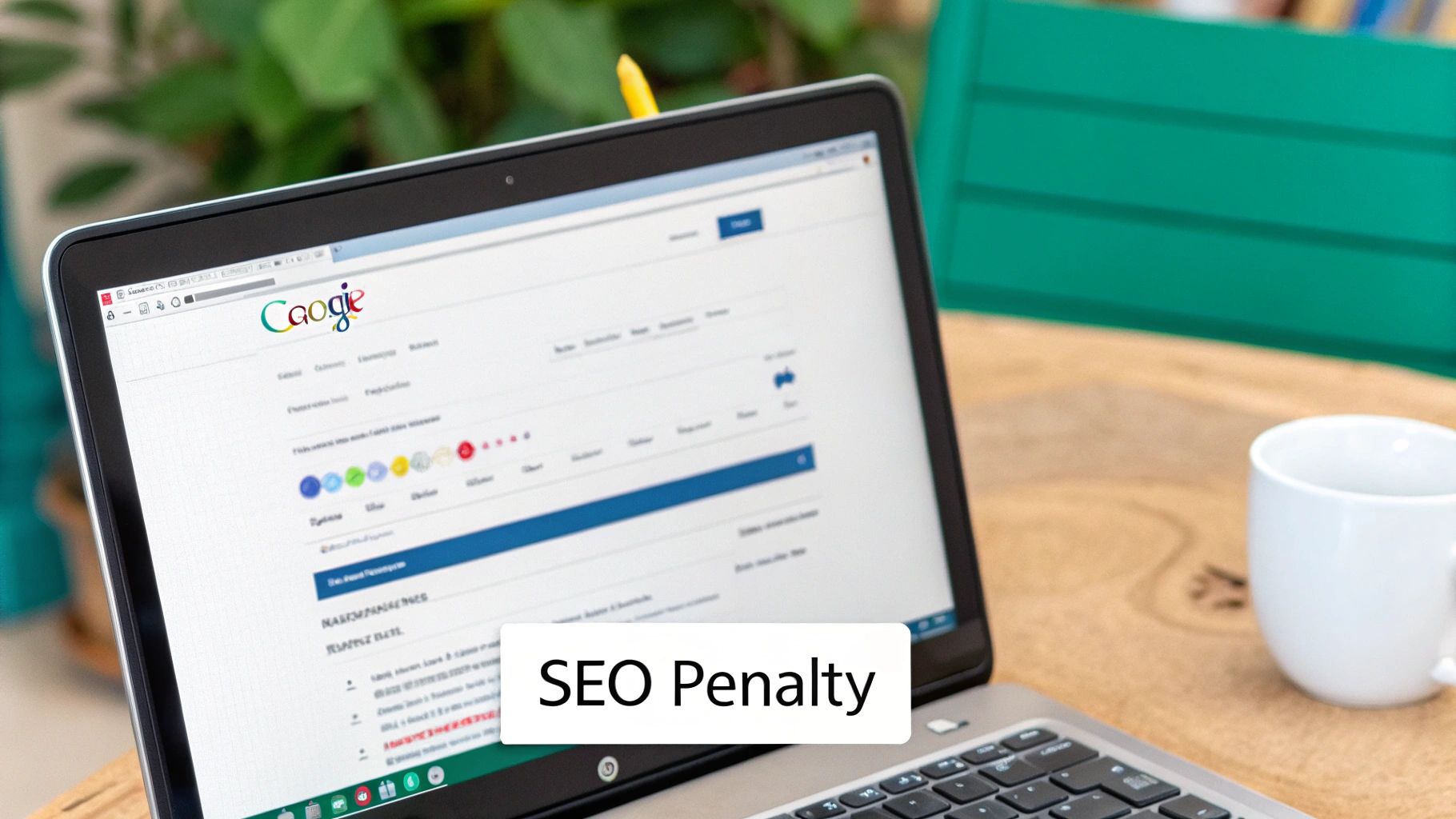The Hidden Cost of a Slow or Outdated Website You Can't Ignore
Discover the hidden cost of a slow or outdated website and how it affects your business growth, SEO, and customer trust. Act now to upgrade today!
The hidden cost of a slow or outdated website isn't some technical problem for your IT person to worry about—it's a direct and constant drain on your revenue. For every single second a potential customer waits for your site to load, you're not just losing their attention; you're losing jobs, damaging your hard-earned reputation, and practically gift-wrapping business for your faster competitors.
It’s a silent profit killer, and the scary part is that most small business owners don't even realise it's happening.
How a Slow Website Quietly Siphons Your Revenue
Let's put this in real-world terms. Imagine your physical shop on a busy Saturday. A queue of keen customers is forming, money in hand, but there's a problem: your front door is jammed. You can only pry it open enough to let one person in every few minutes. What happens next is predictable. Most will get frustrated, give up, and walk straight into your competitor's store next door.
That's exactly what a slow website does to your online business, day in and day out.
For a small business, every single lead and every potential customer matters. A slow-loading page is the digital version of that jammed door. It instantly creates a terrible first impression and tests the patience of visitors who, let's be honest, have come to expect instant gratification online. The longer they're forced to wait, the higher the chance they'll hit the 'back' button and vanish for good.
The Clear Link From Delay to Lost Dollars
This isn't just a theory; it's a measurable financial leak. High bounce rates, where users leave after viewing just one page, and abandoned shopping carts are the most obvious symptoms of a slow site. Each visitor who gives up and leaves represents a lost sale, a missed lead, or an appointment that never gets booked.
This image paints a pretty stark picture of how quickly visitor patience evaporates as load times creep up.

As you can see, there's a critical tipping point. After just a few seconds, you're waving goodbye to a huge chunk of the traffic you've worked so hard to attract.
To really drive this home, let’s look at how these delays translate into actual dollars lost. The table below shows a simplified scenario for a small business, illustrating just how quickly the financial damage adds up.
How Load Time Directly Impacts Your Potential Revenue
| Page Load Time | Potential Visitor Loss | Impact on Conversions | Example Monthly Revenue Loss |
|---|---|---|---|
| 1-3 Seconds | Up to 40% of visitors | Minor drop in enquiries | Minimal loss, but the risk is growing. |
| 3-5 Seconds | 40-50% of visitors | Significant drop in leads | A business earning $10k/month could lose $1,000 - $2,000. |
| 5+ Seconds | Over 50% of visitors | Drastic drop in leads | That same business could lose over $3,000 every month. |
The numbers don't lie. Even a seemingly small delay can have a profound impact on your bottom line. Every second you shave off your load time is a direct investment in protecting your revenue.
The Real-World Financial Impact in Australia
This problem has a very tangible, financial impact on Australian businesses specifically. While Australia's average internet speeds saw a healthy jump of 43.2% in early 2024, many local business websites are still lagging behind, failing to deliver the snappy experience users now expect. The research is clear: Australian businesses can lose around 40% of visitors if a page takes longer than three seconds to load.
For a local business, this isn't just a faceless statistic. A mere one-second delay in your mobile load times can slash your conversion rates by up to 7%. That translates directly into lost jobs and fewer phone calls, week after week.
What this really means is that if your website is sluggish, you are actively turning away paying customers. You can explore more about Australia's digital trends and see just how much speed affects local businesses. Every millisecond counts, and the price of doing nothing is paid in lost sales and missed opportunities for growth.
Why Your Outdated Site is Invisible to Local Customers
It’s a tough reality for many local businesses: you can offer the best service in town, but if customers can’t find you online, you’re practically invisible. Your website's performance is now directly chained to how easily people in your community discover you on Google. It’s simple, really. Google’s job is to provide its users with the best, most relevant answers, and a fast, modern website is a huge tick in the quality box.
An old site that loads at a snail's pace does the exact opposite. When a potential customer clicks your link and gets nothing but a loading symbol, they won't hang around. They'll hit the 'back' button almost instantly. This is what we call a high bounce rate, and it sends a clear signal to Google: this website offers a poor experience. As a result, Google is far less likely to show your site to the next person searching for your services.

The Cost of Invisibility in Local Search
This isn't just a small technical problem; it's a massive hidden cost. Your faster, more modern competitors are being rewarded with higher rankings, pushing them to the top of the page when someone in your suburb searches for a plumber, builder, or landscaper. In effect, they are snapping up customers who were actively trying to find a business just like yours.
The hidden cost of a slow or outdated website is immense in terms of search engine visibility. Slower sites get lower SEO scores, reducing their chance to be seen. Consequently, they lose valuable organic visitors to faster competitors who dominate local search results.
This digital invisibility has a very real financial sting. In Australia, where spending on SEO is projected to hit $1.5 billion by 2025, a slow website means you're leaving a lot of money on the table. You can explore more on how Aussie businesses are investing in their online presence by reviewing these local SEO statistics.
Connecting Your Website to Google Maps and Local Discovery
Being found online is about more than just standard search results. For any local business, a huge number of potential customers find you through Google Maps and the "local pack"—that map and trio of business listings that appears at the very top of the search page.
Believe it or not, your website's health directly impacts your chances of showing up here. A slow, outdated, or mobile-unfriendly site actively harms your local SEO efforts, making it much harder to get that prime real estate. To make sure you’re ticking all the right boxes, our guide on how to get my business on Google Maps is an essential read for any local business owner.
At the end of the day, neglecting your website’s performance means you're not just losing out on direct sales. You're losing the opportunity to even be in the running for a massive slice of your local market.
The Mobile Problem That Is Costing You Customers
Let's be blunt: more of your local customers are searching for you on their phones than ever before. If your website wasn't built with a smartphone screen in mind, it's not just underperforming; it's actively driving away a huge, and growing, slice of your audience.
An old website often just looks broken on a mobile. The text is too small to read, the buttons are impossible to tap accurately, and images can take forever to load or not appear at all. Picture a potential customer, maybe out and about, trying to find your address or phone number. If they're forced to pinch and zoom just to make sense of your site, or can't even tap your "Call Now" button, their patience runs out almost instantly. This is one of the most significant hidden costs you're paying for an outdated site.

Why Mobile Performance Is Non-Negotiable
This isn't a minor inconvenience we're talking about; it has a direct, measurable impact on your revenue. A clunky mobile experience sends potential customers straight into the arms of your competitors whose websites are a breeze to use. The damage to your bottom line is very, very real.
For Australian businesses, the data tells a stark story. One of the clearest hidden costs is the gaping chasm between desktop and mobile conversion rates. On a desktop, users convert at an average rate of 3.2%. On mobile? That number plummets to just 1.8%. That difference is almost entirely down to slow, clunky mobile sites that frustrate people into leaving. You can discover more about these Australian marketing statistics to really understand the scale of the problem.
Ignoring your mobile audience is like locking the front door to half of your potential customers. With median mobile download speeds in Australia hitting 103.46 Mbps in early 2024, people don't just hope for a fast experience – they expect it.
Actionable Steps to Check Your Mobile Health
The good news is you don't need to be a web developer to get a quick read on how your site stacks up. Here are a few simple things any business owner can do right now to check its mobile health:
- Do the Thumb Test: Grab your phone and open your website. Can you easily browse, click, and navigate every part of it using just one thumb? If you find yourself needing to awkwardly reposition your hand or zoom in just to hit a link, your site fails the test.
- Check Key Information: When someone lands on your homepage, can they find your phone number, address, and opening hours within five seconds? This critical info should be impossible to miss.
- Time Your Load Speed: Get a friend to load your site on their phone (on a mobile network, not Wi-Fi) while you time it with a stopwatch. If it takes any longer than three seconds to become usable, you are absolutely losing customers.
How a Bad Website Erodes Brand Trust and Credibility
Your website is your digital storefront. For many people, it’s the very first time they’ll ever interact with your business. Let’s put it in real-world terms: imagine a potential customer walking into your physical shop. If they found it messy, disorganised, and with paint peeling off the walls, what would they think about the quality of your work? Chances are, they’d turn right around and leave, doubting your professionalism.
An outdated, clunky, or broken website has the exact same effect. It silently screams that you might be unreliable, inefficient, or just don't care about the quality of your own business. This is a massive hidden cost of a slow or outdated website, as it corrodes your reputation before you’ve even had a chance to say hello.

This kind of digital neglect plants a seed of doubt. If a business can't even maintain its own website, a customer has to wonder: will they take the same careless approach with my project? This loss of trust can be devastating, and it’s often impossible to measure until the damage is already done.
First Impressions are Digital
In today's market, a staggering 75% of consumers admit to judging a company’s credibility based purely on its website design. A site that looks like it hasn’t been updated since 2010 immediately makes your business look out of touch and far less professional than a competitor with a clean, modern online presence.
This initial judgement happens in a blink of an eye. An unprofessional design, broken links, or those glaring security warnings (all too common on older sites) can instantly make a potential customer uneasy. They aren't just evaluating your services; they're subconsciously assessing your trustworthiness.
An outdated website is like showing up to a client meeting in a stained, wrinkled uniform. It doesn’t matter how skilled you are; the first impression has already undermined your credibility and made the sale that much harder.
What Your Outdated Site Says About You
Whether you realise it or not, your website is always communicating with your customers. An outdated site can send all the wrong signals.
Here’s what potential customers might be thinking:
- "Are they even still in business?" An old copyright date or stale blog posts can easily give the impression you’ve packed up shop.
- "Is this site secure?" That "Not Secure" warning in the browser bar is a huge red flag. Nobody wants to fill out a contact form if they think their data is at risk.
- "They don't care about the details." If your website is littered with typos, broken images, and formatting errors, it suggests a lack of attention to detail that customers will assume carries over into your actual work.
Ultimately, this slow erosion of trust is one of the most damaging hidden costs. A modern, professional website isn't just a marketing expense; it's a fundamental investment in building the confidence and credibility you need to turn a visitor into a paying customer.
Actionable Steps to Diagnose and Revitalise Your Website
Alright, so you know your website might be a bit sluggish. But figuring out why and what to do about it can feel like a job for a tech wizard. The good news? It really isn't. You don't need to be a developer to make some serious improvements. Let's walk through some practical first steps that any small business owner can take.
Getting a quick health check on your site is surprisingly easy and free. The best place to start is with Google's PageSpeed Insights. Just pop in your website address, and it will generate a report card that shows you exactly what’s holding your site back. No more guessing games.
Start With a Simple Diagnosis
Running this first test is a crucial step. It gives you a clear baseline score and a specific to-do list, pointing you directly at the most urgent problems.
Here’s a sneak peek at what a PageSpeed Insights report looks like.
The report spits out easy-to-understand scores for both mobile and desktop versions of your site. More importantly, it highlights the exact issues that are hurting your user experience and, by extension, your search rankings.
Once you have this report in hand, you can start chipping away at the common culprits. You’ll be surprised how many of these fixes are straightforward and don't involve touching a single line of code.
Think of it like a check-up for your most valuable digital asset. You wouldn't let your work ute run poorly without getting a mechanic to look under the bonnet, right? A speed test does the same for your site, showing you what needs a tune-up to prevent a costly breakdown in sales.
Your Simple Checklist for a Faster Website
For almost every common issue that a tool like PageSpeed Insights flags, there’s a simple, actionable solution. Don't let the technical jargon throw you off; just focus on what you can control. This checklist breaks down the biggest offenders and gives you clear steps to fix them.
| Common Problem | How It Hurts Your Site | Actionable Solution for You |
|---|---|---|
| Oversized Images | Big image files are the #1 cause of slow websites. They force visitors to wait and chew through their mobile data. | Use a free tool like TinyPNG or Squoosh to compress your images before uploading them. You can often slash file sizes by over 70% with no visible drop in quality. |
| Slow Web Hosting | Think of your web host as the block of land your website is built on. Cheap, shared hosting is often overcrowded and slow. | Get in touch with your hosting provider to ask about their performance plans. If they can't offer a faster option, it might be time to move to a better home. |
| Too Many Plugins | On platforms like WordPress, a pile of outdated or unnecessary plugins will bog your site down, causing conflicts and security holes. | Go through your plugins. Deactivate and delete anything you don't absolutely need. For the ones you keep, make sure they are always up to date. |
Just by working through these few points, you can make a massive difference to your site's speed and your visitors' experience.
These small, manageable steps are the first moves toward transforming your website from a hidden expense into an asset that actively brings in business. In fact, a simple refresh can have a huge impact on your bottom line. To see just how big, our guide explains how a simple website upgrade can double your leads.
Viewing Your Website as an Investment, Not an Expense
It's all too easy for small business owners to see their website as just another overhead. But after seeing how an old, clunky site can quietly drain your bank account, torpedo your search rankings, and tarnish your reputation, it’s time for a rethink. A modern, high-performance website isn't a cost to be minimised; it's one of the most powerful investments you can make for the future of your business.
Think about it like this: spending a bit now to fix the "hidden costs" we've covered is a proactive business move. On the other hand, doing nothing is purely reactive. It means you're choosing to pay the price through lost customers and missed opportunities, week in and week out. The upfront investment in a great website pays for itself many times over in real, tangible growth.
The Long-Term Rewards of a Modern Website
When you invest in your online presence, you're not just buying a website; you're securing a long-term competitive edge in your local market. A well-built site becomes your tireless, 24/7 salesperson, constantly working to bring in new business.
Here’s what you stand to gain:
- Attracting More Local Customers: A fast, mobile-friendly site naturally climbs the ranks on Google. This puts you front and centre when locals search for the services you offer.
- Achieving Higher Sales Conversions: A smooth, professional online experience instantly builds trust. It makes it incredibly simple for a visitor to take the next step, whether that's picking up the phone or booking a job online. For tradies, this is non-negotiable, and you can dive deeper into how this works in our complete guide to SEO for tradesmen.
- Building Lasting Brand Loyalty: That great first impression doesn't just win you a single job. It builds the credibility and confidence that turns one-off clients into repeat customers who trust your professionalism from the get-go.
Ultimately, the hidden cost of a slow or outdated website is the future growth you sacrifice. A strategic investment in your online presence isn't about spending money—it's about building an asset that generates leads, builds trust, and drives sustainable income for years to come.
Frequently Asked Questions
How much does a new website actually cost a small business?
This is a common question, and the answer really depends. But it's better to think of it as an investment, not just a one-off expense. For a small local business, a new, professionally built website is often far more affordable than you'd think. The real question is, how much is your slow, outdated site costing you every single month in lost jobs and customer trust? That's the figure that truly hurts.
Can't I just fix my old site instead of getting a new one?
You can certainly try. Sometimes small tweaks like compressing a few images or updating a plugin can give you a minor boost.
However, if your website is built on a foundation of old code and outdated technology, you're just putting patches on a rusty ute. You'll end up pouring more time and money into constant repairs just to keep it running, while a new model would be faster, more secure, and actually built to attract today's customers from the get-go.
How quickly will I see a return on my investment?
The impact of a fast, professionally built website can be felt almost straight away. Many small businesses see a noticeable lift in customer enquiries and start climbing the search rankings within a few weeks. When you have a site that works flawlessly on a mobile phone and makes you look like the real deal, it directly translates into more calls and more booked work. The investment starts paying for itself much faster than people expect.
It's a huge misconception that a website is a "set and forget" tool. The biggest hidden cost isn't the build; it's the lost opportunity. Every single day your old site is live, you are actively handing over business to your competitors who have a better online presence. Upgrading is all about capturing that revenue you're currently missing out on.
What if I’m not a tech person at all?
That’s completely fine—in fact, that's the point. Your job is to run your business, not to become a web developer on the side.
The best move for any small business owner is to partner with an expert who lives and breathes this stuff. A good web partner will handle all the technical headaches, manage the entire process, and make sure you end up with a powerful online presence that just works, letting you focus on what you do best.
Stop letting a bad website cost you customers. At SiteStarter, we build high-performance websites for tradesmen that get you found on Google and turn visitors into leads. We handle everything, so you can focus on your work. Get your powerful new website today.